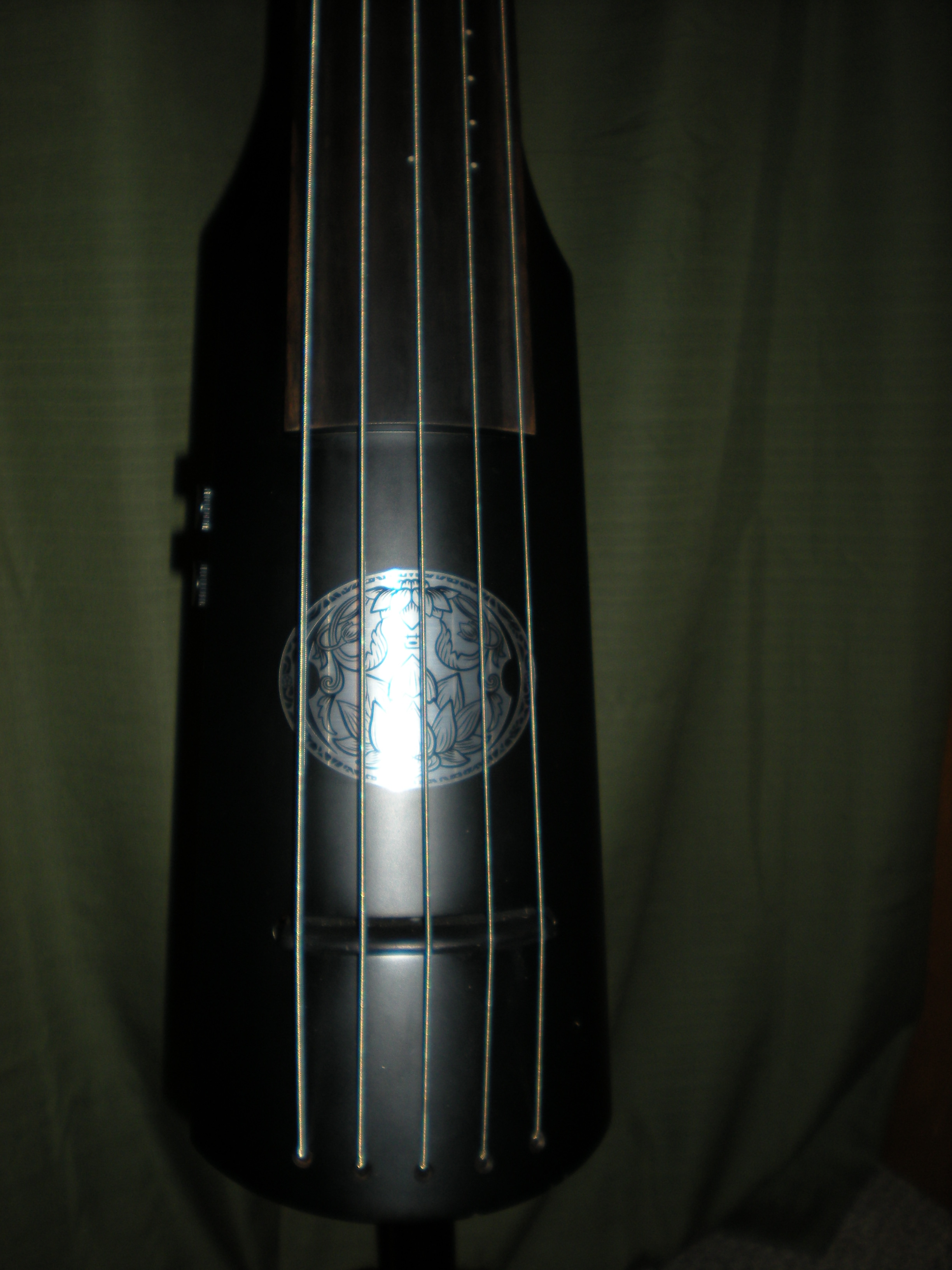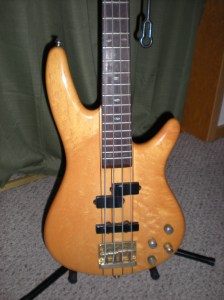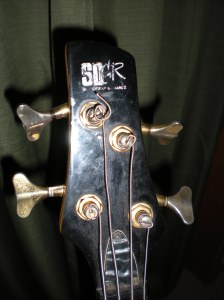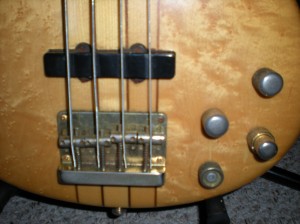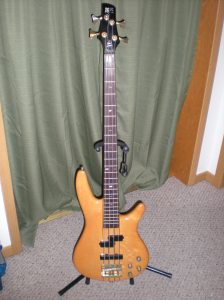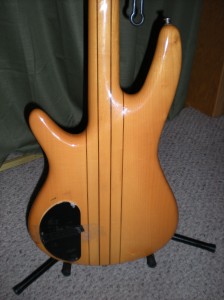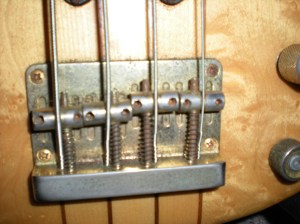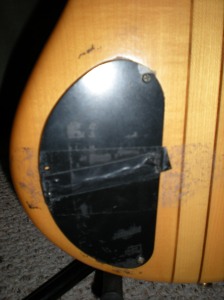I saw the Rocksmith 2014 program for my PS4 in the PlayStation store last week; since the RealTone cable was required to use the program, I instead found a bundle with both the program and the cable. My bundle arrived yesterday, I have already logged three hours of practice/play on it, and I still can’t figure out the answer to that question – is it a tool or a toy?
I was intrigued by Rocksmith because of what it’s not – Guitar Hero. Get the RealTone cable, you plug your own guitar or bass into your console, and you’re good to go. I’ll admit, I’ve never played Guitar Hero (or, if I have – and I may have – I’ve repressed the experience), and I’m snobbish about that – I play real instruments, not press buttons. I had an electronic Simon game when I was a kid, and I’m sure my parents could find it if I really had the urge to do push colored buttons on demand.
While I waited for my bundle to arrive, I saw the add-ons in the PlayStation store – after your initial investment, you can continue to shell out as much as you can afford, as the song library apparently is still growing on a weekly basis. This is both a criticism and a compliment – once I get through the program’s included offerings, I’ll be adding that Smashing Pumpkins bundle to my collection. There’s no need to rush into buying the add-ons, however, as the program comes packed with a selection ranging from The Who and Rush to Artic Monkeys and The Shins. After going straight to the Ramones my first time out to give the program a spin, I’ve been mostly just playing the “recommended” song at the top of the list, whether or not I’m familiar with it. Initially this annoyed me, as I was looking at my accuracy score, and irritated when my score would be relatively low on a song I’d never heard before; now, I see this as a primary advantage of the program, as it forces me outside of my comfort zone.
Getting Started
All right, you get the program, start it up (I had to run an update first – 2014 is the version, which means you’ll surely get to shell out for a new version soon if you go for it), plug in your RealTone cable and calibrate your instrument. I actually went through several guitars (my original intent was to use the program to improve my guitar chops) and basses before settling on my Spector bass. At first, I thought my problem might have been my instruments (I’ve upgraded and wired many of them myself, and while they sound fine through an amp, I generally look in the mirror first when looking for the source of a problem); the Spector is stock, and it seems to work pretty well. Now I’m torn between thinking there might be occasional shorts in the RealTone cable itself, or perhaps more likely, there will just be occasional glitches when you try to use an analog instrument as a digital controller.
The first thing you have to do is set up your focus – Lead Guitar, Rhythm Guitar, or Bass. I started with Lead Guitar, tried Bass, switched again to Rhythm Guitar and back to Lead Guitar, and finally settled back on Bass. It’s a lot of steps, but the point is that the switch is easy to make. The negative is that you also choose your initial difficulty level, but the program then gauges your performance and adjusts accordingly. Great, right? I chose “Novice” for Lead Guitar, but while changing instruments is easy, I couldn’t find anywhere in the menu to change the difficulty – so when I switched to Bass, the level was below my comfort zone, but after doing a few bass exercises, the difficulty was well above my comfort zone on guitar. If you know what you want to use Rocksmith for and stick with it, this won’t be a big deal.
Starting to Play
What you really want to do, though, is play – and Rocksmith offers plenty of ways to do this. Once you’ve set up your track and difficulty, and tune your instrument, you get into the main program menu. Your options are:
- Learn a Song
- Session Mode
- Nonstop Play
- Lessons
- Guitarcade
There’s also a multiplayer mode, but I’m the only one using it on my system – and honestly, if you have another musician to play with, Rocksmith probably isn’t your best playing choice. I haven’t used “Nonstop Play” yet, but it appears to just be a timed practice, with the program playing songs the entire time.
“Learn a Song” is the starting point, both in the menu, and really, in using the program as a whole. As I stated earlier, the basic song library is pretty impressive, and while you might have to purchase add-on songs to get what you’re really after, you’ll probably find something you like to get started.
My first impression is not a good one. I can read music, understand a fair amount of theory, and I’m no snob when it comes to tab – tab is a great way to learn songs quickly. The primary Rocksmith interface is something different altogether. As the song or riff plays, a four-line pattern flows across the screen – and being accustomed to years of looking at bass tab, that was my initial impression. My frustration grew quickly when I learned that the lines represented a section of the fretboard, with the string represented by a color. In all aspects of the game, this is still a problem for me – I learned to play bass with the standard EADG, not the current Red/Yellow/Blue/Orange, so I typically get an error the first time I jump strings while staying on the same fret. The notation also comes toward you as the song plays, making it difficult to see clearly what’s coming up in the song (I’ve played plenty of songs that I’ve never heard before), especially if there’s an open string, indicated by a bar stretching across the notation – and effectively blocking what’s behind it.
If I adjust to the notation, however, the song trainer can actually be a useful practice tool. As I pointed out, the program adjusts its difficulty based on your performance – and this even happens in-song. If the song starts off basic, the program will add additional riffs and techniques, and will even enter “Master” mode, taking away the notation and allowing you to play the song by ear. On the other hand, when I’ve played a song that I’ve never heard before and get a little lost, the program in essence dumbs it down until I build up proficiency.
I’ve only used “Session Mode” a couple of times, but the more I get into the program, the more I suspect this will be one of my favorite tools. You can load a drummer and support instruments and just jam – no score, no funky notation, just a beat and accompaniment to whatever jam you make up. The “Tone Designer” (also on the main menu) gives both options and advice about how to use effects to create your perfect tone, with licensed effects and amps from Marshall, Orange, and Eden; use your tones in Session Mode, and you can get the benefit of thousands of dollars in equipment for the price of the program.
Of course, it takes a while for the drummer to warm up, and that makes it tough to find your groove. Since it plays off of you, it’s no metronome, and you have to focus to keep your time steady – which can be tough if you’re trying to do any kind of groove that’s not a straight 4/4.
The “Lessons” help you get started if you’ve never held a guitar or bass before, and can help you improve your technique even if you’ve been playing for years. Some lessons are just videos, but most start with a video portion demonstrating the technique, followed by a practice portion which asks you to listen to the example then play it yourself, and wraps up with a practice track which forces you to put it all together.
The “Guitarcade” is hit or miss, but may depend on your sound system. I have a decent TV, but don’t have home theater audio, which the game suggests when you boot it up; as a result, a game like “Gone Wailin’” (which asks you to play louder or softer to get bananas) basically turns into an exercise of “play the string hard or not-so-hard” since the actual dynamics don’t cut through the mix of the game music – which ruins what could be a very useful tool. Most of the “Guitarcade” games are set up to look like classic arcade games, and should be fun – I’m a big fan of the “String Skip Saloon,” where I shoot down tough hombres as they bust into the saloon by hitting the appropriate string, and “Duck ReDux” where I shoot ducks by hitting the appropriate fret. But most of the Guitarcade games seem to lack sensitivity, making gameplay frustrating – I’ve already mentioned the weakness with the audio which makes “Gone Wailin’” a good concept poorly executed, but “Ninja Slide N” fails to register when I’ve made my slide, even though I can hear it through the music – and sometimes shout at the TV as I play the required slide two or three times until the game kills me off. I’ve tried playing “Scale Warriors” a few times, but I remain lost on both how the game is supposed to play, and how it is supposed to teach me anything about scales; “Scale Racer” (which has you trying to outrun 5-0 by hitting the indicated degree scale while racing through traffic) does a little better job. Overall, though, the technique trainers in the Guitarcade seem to suffer from not registering the notes played, as if the developer didn’t spend as much time making sure this part of the program worked. It’s a shame, because it honestly has a lot of potential for skill development.
“Score Attack” is located inside the Guitarcade, and is where you take the “Learn a Song” from an accuracy rating to an actual video game score. You can choose to play the song Easy/Medium/Hard, starting with hitting root and accent notes at the beginning, to going through a complete transcription at the upper level. Once you go through the song on Hard without any strikes, you can attempt the Master level, where you play it from memory.
So, Tool or Toy?
I will continue to use Rocksmith 2014, probably because I’m stubborn; I anticipate a long “like/hate” relationship.
I think your enjoyment of the program probably depends on your experience before you use it. I didn’t own a video game console until about six months ago, but I’ve been playing bass longer than most of the PlayStation’s prime market has been alive; I suspect most people who are familiar with any kind of notation would be as confused as I get with the program’s primary interface – my neighbors are probably about ready to have me committed if they hear me shout at the TV again, “It’s the A string, not the yellow string!!! I play music, damn it!!!” On the other hand, if your experience was Guitar Hero, Rocksmith probably makes perfect sense, and your neighbors are happy for you as they hear you gleefully exclaim, “This is so awesome!!! I’m playing real music!!!”
And that’s not intended to be snobbish, it’s just that Rocksmith 2014 seems to be designed for people who are moving from a game like Guitar Hero to actually learning to play a guitar or bass – or for parents who have had that dusty guitar sitting around, and never picked it up until they saw a way to use the game console to pursue their own interests. Even the way the strings are displayed in the interface tends to throw me off when I start playing – and I went from bemused to amused when I realized that it was displaying it in what should be a mirror image for the user, again confusing since it looks so much like tab, but it makes perfect sense if you’re used to seeing the world through selfies. Because the interface is more video game than traditional music notation, I think a novice would have an easier learning curve than a more experienced player.
With Rocksmith bearing a date of 2014, I’m sure we’re about due for an updated program. While I acknowledge that Rocksmith will help me be a better bass player, I would NOT recommend anyone drop the full price on a new version unless the program lags in the lessons and technique trainers are improved. Learning music can be hard enough; you don’t need feedback telling you you’re doing it wrong when the main weakness is a program glitch.
Ultimately, I think Rocksmith is more tool than toy. It overemphasizes imitation, but in so doing, it forces you to perfect your techniques; despite my insane shouting that, “I play real music, not video games!”, part of the frustration is in knowing that the program doesn’t lie, and it’s catching some things I didn’t realize I need to work on.
